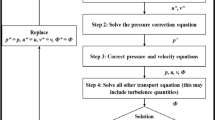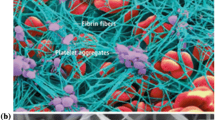Abstract
A new inflation test device was developed to study the mechanical properties of aortic tissue. The device was used to measure failure (rupture) strength and to determine the nonlinear, anisotropic elastic properties of porcine thoracic aorta. The tester was designed to stretch initially flat, circular tissue specimens to rupture under uniform biaxial loading. Water was chosen as the pressurizing fluid. Mechanical stretch and radius of curvature during inflation were measured optically in two orthogonal directions, and the Cauchy stress components were calculated from the deformation and the applied pressure. All porcine samples that ruptured successfully did so via a tear in the circumferential direction. Thus, the failure strength was taken to be the stress in the axial direction immediately prior to rupture. The mean failure strength was 1.75 MPa and mean axial stretch at failure was 1.52. These values agree well with published data for other arterial tissues. The nonlinearly elastic deformation behavior was modeled using a hyperelastic constitutive law of the type proposed by Holzapfel et al. [Holzapfel GA, Gasser TC, Ogden RW. J Elasticity 2000;61:1–48]. The results showed that the dominant directions of anisotropy in the porcine aortas were approximately 45° to the axial and circumferential directions, and that the isotropic contribution to the constitutive model was insignificant.









Similar content being viewed by others
References
Craig RR. Mechanics of materials. 2nd ed. New York: J. Wiley; 2000.
Debes JC, Fung YC. Biaxial mechanics of excised canine pulmonary arteries. Am J Physiol Heart Circ Physiol 1995;269:H433–H442.
Delfino A, Stergiopulos N, Moore JE, Meister JJ. Residual strain effects on the stress in a thick wall finite element model of the human carotid bifurcation. J Biomech 1997;30:777–786.
Fillinger MF, Raghavan ML, Marra SP, Cronenwett JL, Kennedy FE. In vivo analysis of mechanical wall stress and abdominal aortic aneruysm rupture risk. J Vasc Surg 2002;36:589–597.
Fung YC, Fronek K, Patitucci P. Pseudoelasticity of arteries and the choice of its mathematical expression. Am J Physiol 1979;237:H620–H631.
Fung YC. Biomechanics: mechanical properties of living tissue. 2nd ed. New York: Springer-Verlag; 1993.
He CM, Roach MR. The composition and mechanical properties of abdominal aortic aneurysms. J Vasc Surg 1994;20:6–13.
Holzapfel GA, Weizsacker HW. Biomechanical behavior of the arterial wall and its numerical characterization. Comp Biol Med 1998;28:377–392.
Holzapfel GA, Gasser TC, Ogden RW. A new constitutive framework for arterial wall mechanics and a comparative study of material models. J Elasticity 2000;61:1–48.
Hsu FPK, Liu AMC, Downs J, Rigamonti D, Humphrey JD. A triplane video-based experimental system for studying axisymmetrically inflated biomembranes. IEEE Trans Biomed Eng 1995;42:442–450.
Humphrey JD. Mechanics of the arterial wall: Review and directions. Crit Rev Biomed Eng 1995;23:1–162.
Humphrey JD. Cardiovascular solid mechanics. New York: Springer-Verlag; 2002.
Humphrey JD, Kang T, Sakarda P, Anjanappa M. Computer-aided vascular experimentation: a new electromechanical test system. Ann Biomed Eng 1993;21:33–43.
Janz RF. Estimation of local myocardial stress. Am J Physiol 1982;242:H875–H881.
Marra SP, Kennedy FE, Fillinger MF. Mechanical properties characterization of abdominal aortic aneurysm tissue using biaxial testing. ASME Publications BED 2002;54:249–250.
Mohan D, Melvin JW. Failure properties of passive human aortic tissue. I—uniaxial tension tests. J Biomech 1982;15:887–902.
Mohan D, Melvin JW. Failure properties of passive human aortic tissue. II—biaxial tension tests. J Biomech 1983;16:31–44.
Nelder JA, Mead R. A simplex-method for function minimization. Comp J 1965;7:308–313.
Okamoto RJ, Wagenseil JE, DeLong WR, Peterson SJ, Kouchoukos NT, Sundt TM. Mechanical properties of dilated human ascending aorta. Ann Biomed Eng 2002;30:624–635.
Takamizawa K, Hayashi K. Strain energy density function and uniform strain hypothesis for arterial mechanics. J Biomech 1987;20:7–17.
Vande Geest JP, Sacks MS, Vorp DA. Age dependency of the biaxial biomechanical behavior of human abdominal aorta. J Biomech Eng 2004;126:815–822
Vito RP, Hickey J. The mechanical properties of soft tissues – II: the elastic response of arterial segments. J Biomech 1980;13:951–957.
Acknowledgements
This work was supported by the National Institutes of Health via grant NHLBI NIH R01 HL64351-01. Andrew Hughey assisted with the test program.
Author information
Authors and Affiliations
Corresponding author
Appendix—Approximate Stress Caused by Flattening the Specimen Prior to Testing
Appendix—Approximate Stress Caused by Flattening the Specimen Prior to Testing
A rough estimate of that stress caused by flattening out an originally cylindrical specimen can be determined using a mechanics of materials approach (Craig 2000). The bending moment, M, required to flatten a cylindrical specimen of initial radius R is approximately:
where E is the (linear) modulus of elasticity and I is the moment of inertia of the specimen
The maximum bending stress would then be approximately:
where h is the specimen thickness. Using the data from Fig. 8, the approximate elastic modulus for the initial portion of the stress–stretch curve is 3 kPa. For an aorta with initial diameter 1.5 cm and thickness 1.5 mm, the stress resulting from Eq. 10 is then about 0.1 kPa.
Rights and permissions
About this article
Cite this article
Marra, S.P., Kennedy, F.E., Kinkaid, J.N. et al. Elastic and Rupture Properties of Porcine Aortic Tissue Measured Using Inflation Testing. Cardiovasc Eng 6, 123–131 (2006). https://doi.org/10.1007/s10558-006-9021-5
Published:
Issue Date:
DOI: https://doi.org/10.1007/s10558-006-9021-5




